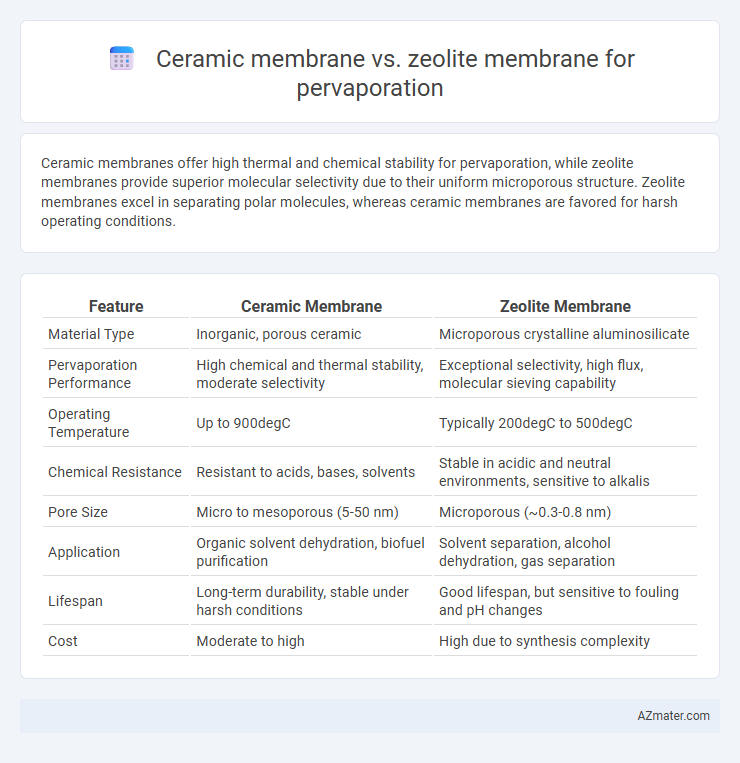Ceramic membranes offer high thermal and chemical stability for pervaporation, while zeolite membranes provide superior molecular selectivity due to their uniform microporous structure. Zeolite membranes excel in separating polar molecules, whereas ceramic membranes are favored for harsh operating conditions.
Table of Comparison
| Feature | Ceramic Membrane | Zeolite Membrane |
|---|---|---|
| Material Type | Inorganic, porous ceramic | Microporous crystalline aluminosilicate |
| Pervaporation Performance | High chemical and thermal stability, moderate selectivity | Exceptional selectivity, high flux, molecular sieving capability |
| Operating Temperature | Up to 900degC | Typically 200degC to 500degC |
| Chemical Resistance | Resistant to acids, bases, solvents | Stable in acidic and neutral environments, sensitive to alkalis |
| Pore Size | Micro to mesoporous (5-50 nm) | Microporous (~0.3-0.8 nm) |
| Application | Organic solvent dehydration, biofuel purification | Solvent separation, alcohol dehydration, gas separation |
| Lifespan | Long-term durability, stable under harsh conditions | Good lifespan, but sensitive to fouling and pH changes |
| Cost | Moderate to high | High due to synthesis complexity |
Introduction to Pervaporation Technology
Pervaporation technology utilizes selective membranes to separate liquid mixtures based on differences in permeability and volatility, enhancing efficiency in solvent recovery and dehydration processes. Ceramic membranes offer high thermal and chemical stability, making them ideal for harsh operating conditions and organic solvent separations. Zeolite membranes provide molecular sieve characteristics with uniform pore sizes, enabling precise separation of small molecules such as water and organics in solute-solvent mixtures.
Overview of Membrane Separation Processes
Ceramic membranes offer high thermal and chemical stability, making them suitable for harsh pervaporation environments, while zeolite membranes provide superior molecular selectivity due to their uniform microporous structure. Both membranes operate based on selective permeation, where the membrane separates components through diffusion driven by partial vapor pressure differences. Pervaporation utilizing these membranes effectively separates liquid mixtures by preferentially transporting specific molecules, enhancing separation performance in applications like solvent dehydration and organic-organic mixtures.
Understanding Ceramic Membranes: Structure and Properties
Ceramic membranes for pervaporation are composed of inorganic materials such as alumina, zirconia, or titania, featuring a highly porous structure with precise pore size distribution that enhances selective permeability and chemical resistance. Their robust thermal and mechanical stability allows operation under harsh conditions, making them ideal for separating organic solvents and water mixtures. Ceramic membranes exhibit excellent long-term durability and resistance to fouling compared to zeolite membranes, which rely on crystalline microporous aluminosilicate frameworks for molecular sieving.
Zeolite Membranes: Composition and Key Features
Zeolite membranes in pervaporation are composed primarily of crystalline aluminosilicate frameworks with uniform micropores that selectively separate molecules based on size and polarity. Key features include high thermal and chemical stability, precise molecular sieving, and excellent hydrophilicity that enhance the efficiency of water removal from organic solvents. Their tunable pore structures and robust framework enable superior selectivity and durability compared to ceramic membranes, making them ideal for dehydration and organic-organic separations.
Performance Comparison: Flux and Selectivity
Ceramic membranes exhibit higher flux rates in pervaporation due to their robust pore structure and thermal stability, enabling efficient mass transfer under harsh operating conditions. Zeolite membranes demonstrate superior selectivity, attributed to their well-defined microporous channels that discriminate molecules based on size and polarity. The trade-off between flux and selectivity makes ceramic membranes favorable for high-throughput applications, while zeolite membranes are preferable for targeted separations requiring high purity.
Thermal and Chemical Stability: Ceramic vs Zeolite
Ceramic membranes exhibit superior thermal stability, often withstanding temperatures above 800degC, making them ideal for high-temperature pervaporation processes. Zeolite membranes demonstrate excellent chemical stability in harsh environments, particularly resistant to acidic and alkaline conditions due to their crystalline aluminosilicate framework. The combination of ceramic's robustness at elevated temperatures and zeolite's chemical resilience informs membrane selection based on specific pervaporation operating conditions.
Scalability and Fabrication Challenges
Ceramic membranes offer superior thermal stability and mechanical strength, making them more scalable for industrial pervaporation applications compared to zeolite membranes. Zeolite membranes face significant fabrication challenges due to their crystalline structure, requiring precise control over synthesis conditions to achieve defect-free layers. The scalability of zeolite membranes is often limited by difficulties in producing large-area, uniform membranes with consistent pore sizes.
Economic Considerations and Cost Analysis
Ceramic membranes exhibit higher initial costs due to advanced manufacturing processes and materials, but their superior durability reduces replacement frequency and maintenance expenses, offering long-term economic advantages in pervaporation applications. Zeolite membranes typically present lower upfront investment and energy consumption, yet their susceptibility to fouling and limited chemical resistance can increase operating costs over time. Cost analysis reveals that ceramic membranes yield better return on investment in harsh or industrial environments, whereas zeolite membranes may be more cost-effective for specific, less demanding separations.
Typical Applications in Industry
Ceramic membranes are widely used in pervaporation for organic solvent dehydration, petrochemical separations, and wastewater treatment due to their chemical stability and high-temperature resistance. Zeolite membranes find typical industrial applications in the separation of alcohol-water mixtures, olefin-paraffin separation, and hydrogen recovery, leveraging their molecular sieving properties and selective adsorption capabilities. Both membrane types enhance efficiency in chemical processing, solvent recovery, and environmental management within petrochemical, pharmaceutical, and biofuel industries.
Future Trends and Research Directions
Ceramic membranes offer superior thermal and chemical stability in pervaporation applications, while zeolite membranes provide precise molecular sieving and high selectivity. Future trends focus on hybrid membrane development combining ceramic robustness with zeolite selectivity to enhance separation efficiency and durability. Research directions emphasize nanoscale engineering, defect control, and advanced fabrication techniques to optimize performance in industrial-scale pervaporation processes.

Infographic: Ceramic membrane vs Zeolite membrane for Pervaporation
 azmater.com
azmater.com